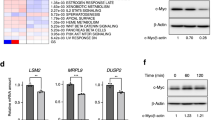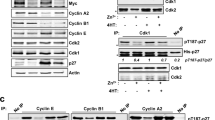Abstract
Our previous work showed that in T98G cells, a human glioblastoma multiforme-derived cell line, the association of c-Fos to the endoplasmic reticulum (ER) and consequently, the capacity of c-Fos to activate phospholipid synthesis, is regulated by the phosphorylation state of tyrosine (tyr) residues #10 and #30 of c-Fos. The small amount of c-Fos present in quiescent cells is tyr-phosphorylated, is dissociated from the ER membranes and does not activate phospholipid synthesis. However, on induction of the cell to re-enter growth, c-Fos expression is rapidly induced, it is found dephosphorylated, associated to ER membranes and activating phospholipid synthesis (Portal et al., 2007). Herein, using in vivo and in vitro experimental strategies, we show that the kinase c-Src is capable of phosphorylating tyr residues of c-Fos whereas the phosphatase TC45 T-cell protein-tyr phosphatase (TC-PTP) dephosphorylates them, thus enabling c-Fos/ER association and activation of phospholipid synthesis. Results also suggest that the regulation of the phosphorylation/dephosphorylation cycle of c-Fos occurs at the TC-PTP level: induction of cells to re-enter growth promotes the translocation of TC45 from a nuclear to a cytoplasmic location concomitant with its activation. Activated TC45 in its turn promotes dephosphorylation of pre-formed c-Fos, enabling cells to rapidly activate phospholipid synthesis to respond to its growth demands.
This is a preview of subscription content, access via your institution
Access options
Subscribe to this journal
Receive 50 print issues and online access
$259.00 per year
only $5.18 per issue
Buy this article
- Purchase on Springer Link
- Instant access to full article PDF
Prices may be subject to local taxes which are calculated during checkout









Similar content being viewed by others
References
Angel P, Karin M . (1991). The role of Jun, Fos and the AP-1 complex in cell proliferation and transformation. Biochim Biophys Acta 1072: 129–157.
Aoki N, Matsuda T . (2002). A nuclear protein tyrosine phosphatase TC-PTP is a potential negative regulator of the PRL-mediated signaling pathway: dephosphorylation and deactivation of signal transducer and activator of transcription 5a and 5b by TC-PTP in nucleus. Mol Endocrinol 16: 58–69.
Borioli GA, Caputto BL, Maggio B . (2001). c-Fos is surface active and interacts differentially with phospholipid monolayers. Biochem Biophys Res Commun 280: 9–13.
Bradford MM . (1976). A rapid and sensitive method for the quantification of microgram quantities of protein utilizing the principle of protein-dye binding. Anal Biochem 7: 248–254.
Bussolino DF, de Arriba Zerpa GA, Grabois VR, Conde CB, Guido ME, Caputto BL . (1998). Light affects c-Fos expression and phospholipid biosynthesis in both retinal ganglion cells and photoreceptor cells. Molec Brain Res 58: 10–15.
Bussolino DF, Guido ME, Gil GA, Borioli GA, Renner ML, Grabois VR et al. (2001). c-Fos associates with the endoplasmic reticulum and activates phospholipid metabolism. FASEB J 15: 556–558.
Caputto BL, Guido ME . (2000). Immediate early gene expression within the visual system: light and circadian regulation in the retina and the suprachiasmatic nucleus. Neurochem Res 25: 153–162.
Cool DE, Tonks NK, Charbonneau H, Walsh KA, Fischer EH, Krebs EG . (1989). cDNA isolated from a human T-cell library encodes a member of the protein-tyrosine-phosphatase family. Proc Natl Acad Sci USA 86: 5257–5261.
Cooper JA, Esch FS, Taylor SS, Hunter TJ . (1984). Phosphorylation sites in enolase and lactate dehydrogenase utilized by tyrosine protein kinases in vivo and in vitro. J Biol Chem 259: 7835–7841.
Crespo PM, Silvestre DC, Gil GA, Maccioni HJF, Daniotti JL, Caputto BL . (2008). c-Fos activates glucosylceramide synthase and glycolipid synthesis in PC12 cells. J Biol Chem 283: 31163–31171.
de Arriba Zerpa GA, Guido ME, Bussolino DF, Pasquaré S, Castagnet PI, Giusto NM et al. (1999). Light stimulation activates retina ganglion cell lysophosphatidic acid acyl transferase and phosphatidic acid phosphatase by a Fos-dependent mechanism. J Neurochem 73: 1228–1235.
Frame MC . (2002). Src in cancer: regulation and consequences for cell behaviour. Biochim Biophys Acta 1602: 114–130.
Galic S, Klingler-Hoffmann M, Fodero-Tavoletti MT, Puryer MA, Meng TC, Tonks NK et al. (2003). Regulation of insulin receptor signaling by the protein tyrosine phosphatase TCPTP. Mol Cell Biol 23: 2096–2108.
Gil GA, Bussolino DF, Portal MM, Pecchio AA, Renner ML, Borioli GA et al. (2004). c-Fos activated phospholipid synthesis is required for neurite elongation in differentiating PC12 cells. Mol Biol Cell 15: 1881–1894.
Guido ME, Caputto BL . (1990). Labeling of retina and optic tectum phospholipids in chickens exposed to light or dark. J Neurochem 55: 1855–1860.
Guido ME, de Arriba GA, Bussolino DF, Caputto BL . (1996). The immediate early gene c-Fos regulates the synthesis of phospholipids but not of gangliosides. J Neurosci Res 43: 93–98.
Hao L, Tiganis T, Tonks NK, Charbonneau H . (1997). The noncatalytic C-terminal segment of the T cell protein tyrosine phosphatase regulates activity via an intramolecular mechanism. J Biol Chem 272: 29322–29329.
Hu X, Dang Y, Tenney K, Crews P, Tsai CW, Sixt KM et al. (2007). Regulation of c-Src nonreceptor tyrosine kinase activity by bengamide A through inhibition of methionine aminopeptidases. Chem Biol 14: 764–774.
Hunter T . (2000). Signaling—2000 and beyond. Cell 100: 113–127.
Hunter T . (2009). Tyrosine phosphorylation: thirty years and counting. Curr Opin Biol 21: 140–146.
Ibarra-Sanchez M, Simoncic PD, Nestel FR, Duplay P, Lapp WS, Tremblay ML . (2000). The T-cell protein tyrosine phosphatase. Semin Immunol 12: 379–386.
Julien SG, Dubé N, Hardy S, Tremblay ML . (2011). Inside the human cancer tyrosine phosphatome. Nat Rev Cancer 11: 35–49.
Klingler-Hoffmann M, Fodero-Tavoletti MT, Mishima K, Narita Y, Cavenee WK, Furnari FB et al. (2001). The protein tyrosine phosphatase TCPTP suppresses the tumorigenicity of glioblastoma cells expressing a mutant EGF receptor. J Biol Chem 276: 46313–46318.
Kouzarides T, Ziff E . (1989). Leucine zippers of Fos, Jun and GCN4 dictate dimerization specificity and thereby control DNA binding. Nature 340: 568–571.
Lorenzen JA, Dadabay CY, Fischer EH . (1995). COOH-terminal sequence motifs target the T-cell protein tyrosine phosphatase to the endoplasmic reticulum and nucleus. J Cell Biol 131: 631–643.
Mattila E, Pellinen T, Nevo J, Vuoriluoto K, Arjonen A, Ivaska J . (2005). Negative regulation of EGFR signaling through integrin-alpha1beta1-mediated activation of protein tyrosine phosphatase TCPTP. Nat Cell Biol 7: 78–85.
Meng TC, Buckley DA, Galic S, Tiganis T, Tonks NK . (2004). Regulation of insulin signaling through reversible oxidation of the protein-tyrosine phosphatases TC45 and PTP1B. J Biol Chem 279: 37716–37725.
Morgan J, Curran T . (1995). Immediate early genes: ten years on. Trends Neurosci 18: 66–67.
Oppermann H, Levinson, AD, Varmus HE, Levintow L, Bishop JM . (1979). Uninfected vertebrate cells contain a protein that is closely related to the product of the avian sarcoma virus transforming gene (src). Proc Natl Acad Sci USA 76: 1804–1808.
Portal MM, Ferrero GO, Caputto BL . (2007). N-terminal c-Fos tyrosine phosphorylation regulates c-Fos/ER association and c-Fos-dependent phospholipid synthesis activation. Oncogene 26: 3551–3558.
Sambrook J, Russel DW . (2001). Molecular Cloning: A Laboratory Manual, Third Edition. Cold Spring Harbor Laboratory Press: New York. pp 13.19–13.25.
Silvestre DC, Gil GA, Tomasini N, Bussolino DF, Caputto BL . (2010). Growth of peripheral and central nervous system tumors is supported by cytoplasmic c-Fos in humans and mice. PLoS One 5: e9544.
Simoncic PD, Lee-Loy A, Barber DL, Tremblay ML, McGlade CJ . (2002). The T cell protein tyrosine phosphatase is a negative regulator of Janus family kinases 1 and 3. Curr Biol 12: 446–453.
Tiganis T . (2002). Protein tyrosine phosphatases: dephosphorylating the EGF receptor. IUBMB Life 53: 3–14.
Tiganis T, Bennett AM, Ravichandran KS, Tonks NK . (1998). Epidermal growth factor receptor and the adaptor protein p52Shc are specific substrates of T-cell protein tyrosine phosphatase. Mol Cell Biol 18: 1622–1634.
Tiganis T, Flint AJ, Adam SA, Tonks NK . (1997). Association of the T-cell protein tyrosine phosphatase with nuclear import factor p97. J Biol Chem 272: 21548–21557.
Tiganis T, Kemp BE, Tonks NK . (1999). The protein tyrosine phosphatase TCPTP regulates EGF receptor-mediated and phosphatidyl- inositol 3-kinase-dependent signalling. J Biol Chem 274: 27768–27775.
Wälchli S, Curchod ML, Gobert RP, Arkinstall S, Hooft van Huijsduijnen R . (2000). Identification of tyrosine phosphatases that dephosphorylate the insulin receptor. A brute force approach based on “substrate-trapping” mutants. J Biol Chem 275: 9792–9796.
Yamamoto T, Sekine Y, Kashima K, Kubota A, Sato N, Aoki N et al. (2002). The nuclear isoform of protein-tyrosine phosphatase TC-PTP regulates interleukin-6-mediated signaling pathway through STAT3 dephosphorylation. Biochem Biophys Res Commun 297: 811–817.
Acknowledgements
We thank HJF Maccioni for helpful discussions and H Carbonneau (Pardue University, West Lafayette, IN, USA) for providing pET-TC45a. pCG-TC45 and pCG-D182A were kind gifts from T Tiganis (Cold Spring Harbor Laboratory, New York, NY, USA) and pET-c-Src from MA Seelinger (University of California, Berkeley, CA, USA). Excellent technical assistance from Susana Deza and Gabriela Schachner is acknowledged. This work was supported by grants from the ANPCyT and CONICET, Ministerio de Ciencia, Tecnología e Innovación Productiva de Argentina, SECyT-Universidad Nacional de Córdoba, Argentina and the JS McDonnell Foundation. BLC is a career member and GOF and FV are fellows of CONICET.
Author information
Authors and Affiliations
Corresponding author
Ethics declarations
Competing interests
The authors declare no conflict of interest.
Rights and permissions
About this article
Cite this article
Ferrero, G., Velazquez, F. & Caputto, B. The kinase c-Src and the phosphatase TC45 coordinately regulate c-Fos tyrosine phosphorylation and c-Fos phospholipid synthesis activation capacity. Oncogene 31, 3381–3391 (2012). https://doi.org/10.1038/onc.2011.510
Received:
Revised:
Accepted:
Published:
Issue Date:
DOI: https://doi.org/10.1038/onc.2011.510
Keywords
This article is cited by
-
Up-Regulation of c-Fos Associated with Neuronal Apoptosis Following Intracerebral Hemorrhage
Cellular and Molecular Neurobiology (2015)
-
MR-1 blocks the megakaryocytic differentiation and transition of CML from chronic phase to blast crisis through MEK dephosphorylation
Blood Cancer Journal (2013)
-
Controlling Cytoplasmic c-Fos Controls Tumor Growth in the Peripheral and Central Nervous System
Neurochemical Research (2012)



